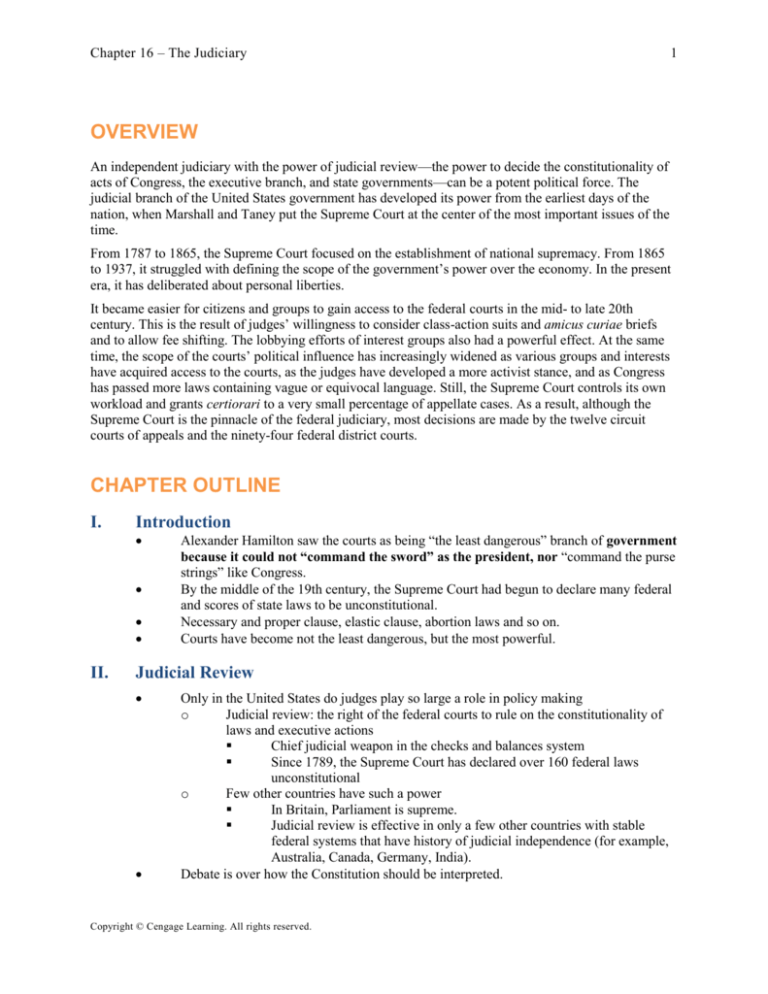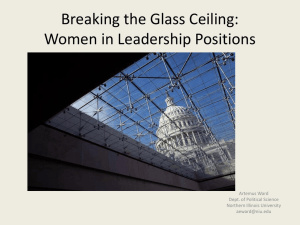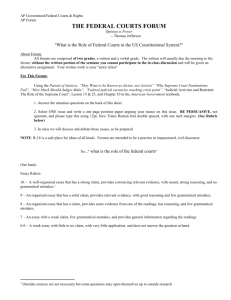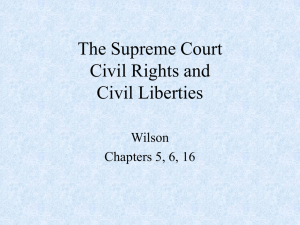
Chapter 16 – The Judiciary
1
OVERVIEW
An independent judiciary with the power of judicial review—the power to decide the constitutionality of
acts of Congress, the executive branch, and state governments—can be a potent political force. The
judicial branch of the United States government has developed its power from the earliest days of the
nation, when Marshall and Taney put the Supreme Court at the center of the most important issues of the
time.
From 1787 to 1865, the Supreme Court focused on the establishment of national supremacy. From 1865
to 1937, it struggled with defining the scope of the government’s power over the economy. In the present
era, it has deliberated about personal liberties.
It became easier for citizens and groups to gain access to the federal courts in the mid- to late 20th
century. This is the result of judges’ willingness to consider class-action suits and amicus curiae briefs
and to allow fee shifting. The lobbying efforts of interest groups also had a powerful effect. At the same
time, the scope of the courts’ political influence has increasingly widened as various groups and interests
have acquired access to the courts, as the judges have developed a more activist stance, and as Congress
has passed more laws containing vague or equivocal language. Still, the Supreme Court controls its own
workload and grants certiorari to a very small percentage of appellate cases. As a result, although the
Supreme Court is the pinnacle of the federal judiciary, most decisions are made by the twelve circuit
courts of appeals and the ninety-four federal district courts.
CHAPTER OUTLINE
I.
Introduction
II.
Alexander Hamilton saw the courts as being “the least dangerous” branch of government
because it could not “command the sword” as the president, nor “command the purse
strings” like Congress.
By the middle of the 19th century, the Supreme Court had begun to declare many federal
and scores of state laws to be unconstitutional.
Necessary and proper clause, elastic clause, abortion laws and so on.
Courts have become not the least dangerous, but the most powerful.
Judicial Review
Only in the United States do judges play so large a role in policy making
o
Judicial review: the right of the federal courts to rule on the constitutionality of
laws and executive actions
Chief judicial weapon in the checks and balances system
Since 1789, the Supreme Court has declared over 160 federal laws
unconstitutional
o
Few other countries have such a power
In Britain, Parliament is supreme.
Judicial review is effective in only a few other countries with stable
federal systems that have history of judicial independence (for example,
Australia, Canada, Germany, India).
Debate is over how the Constitution should be interpreted.
Copyright © Cengage Learning. All rights reserved.
Chapter 16 – The Judiciary
o
o
III.
2
Judicial restraint approach (strict-constructionist): judges are bound by wording
of Constitution
Activist approach: judges should look to underlying principles of Constitution
o
Not a matter of liberal versus conservative
A judge can be both conservative and activist, or liberal and
strict constructionist.
Today, most activists tend to be liberal; most strict
constructionists tend to be conservative.
The Development of the Federal Courts (THEME A: THE HISTORY OF THE
FEDERAL JUDICIARY)
Founders’ view
o
Most Founders probably expected judicial review but did not expect federal court
to play such a large role in policy making.
o
Traditional view: judges find and apply existing law
o
Activist judges would later respond that judges also make law.
o
Traditional view made it easy for Founders to predict courts would be neutral and
passive in public affairs.
o
Hamilton: Courts are the least dangerous branch; their authority only limits the
legislature.
o
But federal judiciary evolved toward judicial activism, shaped by political,
economic, ideological forces of three historical eras.
A.
NATIONAL SUPREMACY AND SLAVERY: 1789 to 1861
B.
Marbury v. Madison (1803) and McCulloch v. Maryland (1819)
o
Supreme Court could declare a congressional act unconstitutional.
o
Power granted to federal government should be construed broadly
o
Federal law is supreme over state law.
Other cases: interstate commerce clause is placed under the authority of federal
law; state law conflicting with federal law was declared void
Dred Scott v. Sandford (1857): blacks were not, and could not become, free
citizens of the United States; federal law (Missouri Compromise) prohibiting
slavery in northern territories was unconstitutional.
GOVERNMENT AND THE ECONOMY: 1865 TO 1936
Dominant issues of the period
o
Under what circumstances could the state governments regulate the
economy?
o
When could the federal government do so?
Private property held to be protected by the Fourteenth Amendment
Judicial activism was born as the Supreme Court began to assess the
constitutionality of governmental regulation of business or labor.
Supreme Court was supportive of private property, but could not develop a
principle distinguishing between reasonable and unreasonable regulation of
business.
The Court interpreted the Fourteenth and Fifteenth Amendments narrowly as
applied to blacks; it upheld segregation and permitted blacks to be excluded from
voting in many states.
Copyright © Cengage Learning. All rights reserved.
Chapter 16 – The Judiciary
C.
GOVERNMENT AND POLITICAL LIBERTY: 1936 TO THE PRESENT
D.
Court establishes tradition of deferring to the legislature in economic regulation
cases.
Court shifts attention to personal liberties and is active in defining rights.
Failed court-packing plan (FDR); “the switch in time that saved nine”
Warren Court provided a liberal protection of rights and liberties against
government trespass.
THE REVIVAL OF STATE SOVEREIGNTY
IV.
3
Beginning in 1992, the Supreme Court began to rule that the states have the right
to resist some federal action.
Reassertion of limits to federal supremacy in cases involving gun control, Indian
tribe lawsuits.
President Obama’s health plan challenged on the grounds that the requirement
that all citizens purchase health insurance is an excessive use of the commerce
clause and therefore unconstitutional.
The Structure of the Federal Courts
Two kinds of federal courts were created by Congress to handle cases that the Supreme
Court does not need to decide.
o
Constitutional courts exercise judicial powers found in Article III
Judges serve during good behavior
Salaries not reduced while in office
Examples: district courts (94), courts of appeals (12)
o
Legislative courts
Created by Congress for specialized purposes
Judges have fixed terms
Judges can be removed
No salary protection
Example: Court of Military Appeals
A.
SELECTING JUDGES
Judicial behavior
o
Party background has a strong effect on judicial behavior.
o
Other factors also shape court decisions: facts of the case, prior rulings,
and legal arguments.
1.
SENATORIAL COURTESY
Appointees for federal courts are reviewed by senators from that state, if
the senators are of the president’s party (particularly for U.S. district
courts).
Gives heavy weight to preferences of senators from state in which judge
will serve
Copyright © Cengage Learning. All rights reserved.
Chapter 16 – The Judiciary
2.
THE “LITMUS TEST”
V.
4
Litmus test: a test of ideological purity
Presidents seek judicial appointees who share their political ideologies.
Has caused different circuits to come to different rulings about similar
cases.
Raises concerns that ideological tests are too dominant; has led to sharp
drop in the percentage of nominees to federal appeals courts who are
confirmed
A judicial nominee’s view on abortion is the chief reason for use of a
litmus test.
The threat of a filibuster aimed at blocking Senate confirmation has led
to a situation where the nominee must have the support of at least sixty
senators to guarantee that a cloture vote would stop a threatened
filibuster. This has led to a great deal of legislative maneuvering with
controversial nominees.
In recent years nominees almost always have been judges in lower
courts.
The Jurisdiction of the Federal Courts
Dual court system
o
State court systems, federal court system
o
Federal cases listed in Article III and Eleventh Amendment of Constitution
Federal question cases: involving U.S. Constitution, federal law, treaties
Diversity cases: involving different states, or citizens of different states
o
Some cases can be tried in either federal or state court
Example: if both federal and state laws have been broken (dual
sovereignty; the Rodney King case)
Jurisdiction: each government has right to enact laws and neither can
block prosecution out of sympathy for the accused.
o
Some cases that begin in state courts can be appealed to Supreme Court.
o
Controversies between two state governments can be heard only by Supreme
Court.
Route to the Supreme Court
o
Most federal cases begin in district courts
Most are straightforward and do not lead to new public policy
Volume is huge: About 650 district court judges received over 300,000
cases.
o
Supreme Court picks the cases it wants to hear on appeal.
Requires agreement of four justices (or a writ of certiorari) to hear case
Supreme Court generally only agrees to review certain types of cases,
involving:
A significant federal or constitutional question
Conflicting decisions by circuit courts
Constitutional interpretation by one of the highest state courts,
about state or federal law
Court may consider seven thousand petitions each year, but only about
one hundred are granted.
Limited number of cases heard results in diversity of constitutional
interpretation among appeals courts.
Copyright © Cengage Learning. All rights reserved.
Chapter 16 – The Judiciary
VI.
5
Increased workload has led to greater influence of law clerks.
Help to decide which cases should be heard under a writ of
certiorari
May draft initial opinions for the justices
Getting to Court
Deterrents to the courts acting as democratic institutions
o
Supreme Court rejects all but a few of the applications for certiorari.
o
Costs of appeal are high.
Financial costs, including filing, record, and attorney fees, are high, but
may be lowered for some.
In forma pauperis: plaintiff indigent, with costs paid by
government
Indigent defendant in a criminal trial: legal counsel provided by
government at no charge
Payment by interest groups (for example, American Civil
Liberties Union)
Cost in terms of time is also high and cannot be mitigated.
A.
FEE SHIFTING
B.
STANDING
C.
Usually each party must pay its own legal expenses.
The losing defendant pays the plaintiff’s expenses (fee shifting) in certain cases.
Guidelines regarding who is entitled to bring a case
o
There must be a real controversy between adversaries.
o
Personal harm must be demonstrated.
o
Being a taxpayer does not ordinarily constitute entitlement to challenge
federal government action; this requirement is relaxed when the First
Amendment is involved.
Sovereign immunity
o
Government must consent to being sued.
o
By statute, government has given its consent to be sued in cases
involving contract disputes and negligence.
CLASS-ACTION SUITS
Brought on behalf of all similarly situated persons
Number of class-action suits increased, because there were financial incentives to
bringing suit and because Congress was not meeting new concerns.
In 1974, Supreme Court tightened rules on these suits for federal courts, though
many state courts remain accessible.
Big class-action suits affect how courts make public policy (such as asbestos,
silicone breast implants).
Copyright © Cengage Learning. All rights reserved.
Chapter 16 – The Judiciary
6
VII. The Supreme Court in Action (THEME B: THE SUPREME COURT IN ACTION)
Most cases arrive at the Court through a writ of certiorari.
Lawyers then submit briefs: documents that set forth the facts of the case, summarize the
lower court decision, give the argument of that side of the case, and discuss other issues.
Oral arguments by lawyers after briefs submitted
o
Each side has one half-hour.
o
Justices can interrupt with questions.
Since federal government is a party to almost half the cases, the solicitor general
frequently appears before the courts.
o
Solicitor general: federal government’s top trial lawyer
o
Decides what cases the government will appeal from lower courts
o
Approves every case presented to the Supreme Court
A.
Justices may also consider other opinions.
o
Amicus curiae briefs submitted if both parties agree or Supreme Court grants
permission.
o
Other influences on the justices include legal periodicals.
Conference procedures
o
Role of chief justice: speaking first, voting last
o
Senior judge on winning side selects opinion writer
o
Four kinds of court opinions
Per curiam: brief and unsigned
Opinion of the court: majority opinion
Concurring opinion: agree with the ruling of the majority opinion, but
modify the supportive reasoning
Dissenting opinion: minority opinion
About two-fifths of decisions are unanimous. In this case the law is clear
and no difficult questions of interpretation exist.
The other three-fifths appear to be two main blocs and one swing vote on
today’s court:
Conservative bloc: Alito, Roberts, Scalia, and Thomas
Liberal bloc: Breyer, Ginsburg, Stevens, and probably
Sotomayor
Swing vote: Kennedy
VIII. The Power of the Federal Courts (THEME C: THE POWER OF THE FEDERAL
JUDICIARY)
A.
THE POWER TO MAKE POLICY
The courts make policy:
o
by interpretation of the Constitution or law;
o
by extending the reach of existing law; and
o
by designing remedies that involve judges acting in administrative or
legal ways
Measures of power
o
Number of laws declared unconstitutional (over 160)
o
Number of prior cases overturned; not following stare decisis (over 260
cases since 1810)
o
Extent to which judges will handle cases once left to the legislature
(political questions)
Copyright © Cengage Learning. All rights reserved.
Chapter 16 – The Judiciary
o
o
B.
Supporters
o
Courts should correct injustices when other branches or state
governments refuse to do so.
o
Courts are the last resort for those without the power or influence to gain
new laws.
Critics
o
Judges lack expertise in designing and managing complex institutions.
o
Initiatives require balancing policy priorities and allocating public
revenues.
o
Courts are not accountable, because judges are not elected.
Possible reasons for activism
o
Adversary culture, emphasizing individual rights and suspicion of
government power.
o
Easier to get standing in courts
LEGISLATION AND THE COURTS
IX.
Most significant indicator is kinds of remedies imposed; judges often
impose remedies that affect large populations
Basis for sweeping orders can come either from the Constitution or from
court interpretation of federal laws.
VIEWS OF JUDICIAL ACTIVISM
C.
7
Laws and the Constitution are filled with vague language, which increase courts’
opportunities to design remedies.
Federal government is increasingly on the defensive in court cases; laws induce
court challenges.
Attitudes of federal judges affect their decisions when the law gives them
latitude.
Checks on Judicial Power
Basic restraints on judicial power
o
Judges have no enforcement mechanisms (police force or army); thus, their
decisions can be resisted or ignored (for instance, Bible reading in schools,
segregation in schools).
o
Resistance depends on visibility of disobedience.
A.
CONGRESS AND THE COURTS
o
o
o
Confirmation and impeachment proceedings gradually alter composition of
courts, though impeachment is an extraordinary and unusual event.
Changing the number of judges gives president more or fewer appointment
opportunities.
Supreme Court decisions can be undone by:
Revising legislation
Amending the Constitution
Altering jurisdiction of the Court
Restricting Court remedies
Copyright © Cengage Learning. All rights reserved.
Chapter 16 – The Judiciary
B.
PUBLIC OPINION AND THE COURTS
Defying public opinion—especially the opinion of the elites—may destroy the
legitimacy of the institution.
Opinion in realigning eras may energize Court.
Public confidence in the Supreme Court since 1966 has varied with popular
support for the government, generally.
No overt attempts to curb judicial activism
o
Activism has increased because government does more, and courts must
interpret the laws.
o
Activist ethos of judges is now more widely accepted.
Copyright © Cengage Learning. All rights reserved.
8










